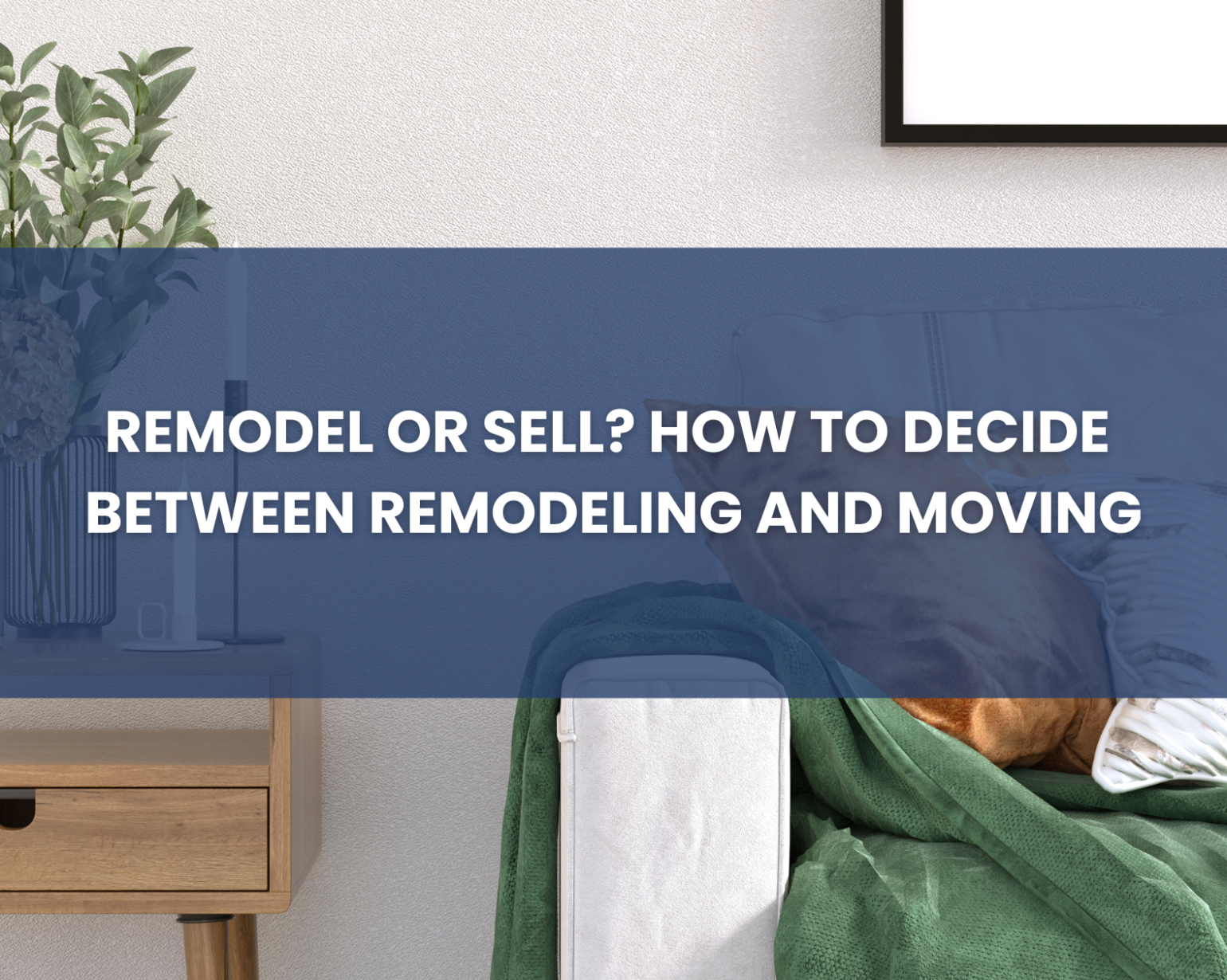Remodel or Sell? How to Decide Between Remodeling and Moving

If you’ve ever walked through your house and thought, “This just isn’t working for us anymore,” you’re not alone. Maybe the kitchen’s too tight, the layout doesn’t flow, or your home just doesn’t fit your lifestyle anymore. When that thought hits, the big question is: Should we remodel or move?
It’s not a simple choice—and it’s not just about money. At Thayer Design Build, we’ve helped many Corvallis-area homeowners weigh this exact decision. In this article, we’ll break down the five biggest factors to consider:
- Financial Costs
- Lifestyle and Emotional Factors
- The Value of Location
- Functionality and Vision
- Time and Stress
By the end, you’ll have a clearer picture of which path makes the most sense for your home—and your life.
Remodeling Costs vs. Moving Costs: What to Expect Financially

Let’s be honest—neither option is cheap. Whether you remodel or move, you’re looking at a major financial investment. The real question is: Where do you want that money to go?
Remodeling often comes with a higher upfront cost than people expect. (Check out our Home Remodeling Cost Guide to see actual numbers!) Depending on the scope, a major renovation can easily reach six figures. But that money is going into a space you already own—one you can shape to your lifestyle and taste. And in many cases, it adds lasting value to your home.
Moving might seem like a simpler fix, but it’s expensive in its own right. Between realtor commissions, closing costs, moving expenses, and potential renovations in the new place, the true cost of moving often climbs higher than anticipated. And if you’re buying a more expensive home, you’re likely taking on a larger mortgage—possibly at a much higher interest rate than you have now.
So while both paths require a significant investment, the better choice depends on what you’re getting in return. For example:
- Would $150,000 spent on remodeling give you the custom kitchen, layout, and storage you want?
- Or would spending $150,000 more on a new home actually solve your pain points—or just trade them for new ones?
Remodeling also gives you more control over budget and timing. You can phase projects as needed, prioritize key updates, and avoid the pressure of bidding wars or rushed decisions in a hot market.
What we’ve seen: Many of our clients discover that after comparing the full financial picture, they’d rather invest in improving the home they already love than take on the unknowns of a move.
Emotional and Lifestyle Considerations: What Change Really Costs

Your home is more than a building—it’s part of your family’s story. It’s where birthdays are celebrated, backpacks pile up by the door, and where your kids know which stair creaks on the way to the kitchen. These things might not show up on a spreadsheet, but they matter.
That’s why decisions like this carry emotional weight. Before you focus purely on logistics, ask:
- What does “home” mean to us?
- How would a major change affect our kids’ sense of safety and belonging?
- Are we craving a fresh start—or simply outgrowing a space that could evolve?
Remodeling gives you the chance to improve your home without losing the life already built inside it. You maintain your daily routines, your kids stay in familiar spaces, and the small comforts—like the way morning light hits the kitchen table—don’t have to disappear.
Sure, living through construction isn’t a highlight reel. But, with the right planning and support, it’s a temporary inconvenience for a long-term gain. And unlike moving, you’re not starting from zero—you’re building on something meaningful.
Moving can offer a clean slate, but it also asks your family to let go of what’s known. That’s a bigger emotional shift than most people expect, especially for children.
Bottom line: If your home still feels emotionally right but needs an update, remodeling gives you the chance to preserve what your family loves—while finally fixing what you don’t.
Why Location Matters More Than You Think

When people say “location, location, location,” they’re not just talking about real estate value—they’re talking about your life.
Where your home sits affects everything from your morning commute to where your kids go to school, who they play with, how safe they feel, and even how often you see friends and family.
Here are some of the real factors to think about:
- Street traffic — Are you on a quiet cul-de-sac or a busy road?
- Proximity to work and school — Are your routines streamlined or stretched thin?
- Neighborhood vibe — Is it social and friendly? Or quiet and private?
- Access to parks, trails, and shopping — Can your kids ride bikes to the playground? Can you walk to the grocery store?
- Backyard and outdoor space — Is it big enough for your lifestyle?
- Urban vs. rural — Is convenience or peace and privacy more important to your day-to-day?
Remodeling lets you preserve the location you’ve already vetted and chosen. You stay rooted in the rhythms that work for your family while upgrading the parts of the home that don’t.
Moving, on the other hand, reintroduces uncertainty. That charming new neighborhood might seem ideal—but you won’t really know how it feels until you’ve lived there. And rebuilding your community, your habits, and your support network takes time.
Our take: If your current location works for your life, that’s an asset you shouldn’t overlook. Remodeling lets you improve your home without trading away the convenience, comfort, and connection you’ve already built.
Functionality & Vision: Can Your Home Become What You Need?

Sometimes the problem isn’t style—it’s how the space works. Maybe the kitchen is isolated, the bedrooms are too small, or there’s just no place for guests, work, or daily life to comfortably unfold.
Remodeling gives you the opportunity to reshape your home around your lifestyle. With the right team, you can:
- Open up walls for better flow
- Create more usable space
- Improve natural light and storage
- Add new features like a home office, primary suite, or better indoor-outdoor connection
But vision only works if the house—and lot—can support it.
Sometimes the lot size makes adding square footage nearly impossible. Setback requirements, lot coverage restrictions, or tight spacing between homes can create hard limits. And in some cases, the existing structure may have fundamental layout issues or outdated infrastructure that makes remodeling more complicated and expensive than expected.
That doesn’t mean remodeling is off the table—but it does mean you need a clear-eyed evaluation of what’s possible, and whether the investment gets you the home you actually want.
Our take: If your house has good bones, a workable lot, and a vision you’re excited about, remodeling is a powerful way to create a home that’s truly yours—without starting over somewhere new.
Time and Stress: Both Paths Take Work—Just in Different Ways

Let’s be real: remodeling and moving are both stressful in their own ways. There’s no easy button. The real difference is where the stress shows up—and how much of it you want to manage yourself.
Moving starts long before the boxes. First, there’s getting your current home ready to list: cleaning, staging, repairing, landscaping—all while trying to keep it spotless for showings. Then comes the emotional ride of offers, counteroffers, inspections, and the dreaded possibility of a deal falling through. If you’re buying and selling at the same time, that adds another layer: waterfall offers, timing pressure, and trying to align two major financial transactions without dropping the ball on either.
Even with a great real estate agent, it’s a complex, high-stakes dance. And once that’s done, you’re still looking at packing, moving, and often updating the new place before you can truly settle in.
Remodeling has its own challenges: choosing a contractor, making design decisions, and navigating daily life during construction. But the disruption is focused. You’re not packing your life into boxes or gambling on a tight market. And if you’re working with a design-build firm with a seamless process, the heavy lifting—project management, design coordination, and scheduling—is handled for you.
In either case, success depends on who you partner with. A top-notch real estate agent can make a move feel smooth and empowering. A solid design-build contractor can make renovation surprisingly low-stress. But poor guidance in either direction? That’s where stress multiplies.
Here’s the truth: Both paths take time, energy, and resilience. Both come with emotional swings. But both are worth it—if the end result is a home that finally feels right for you.
How the Real Estate Market Shapes the Remodel vs. Move Decision

The real estate market has a huge impact on your options—whether you’re buying or remodeling. But that impact plays out in different ways.
If it’s a seller’s market, you might get top dollar for your current home—but you’ll likely face high prices, limited inventory, and competitive bidding on your next one. You win on the sale, but could lose on the buy.
In a buyer’s market, there may be more homes to choose from and better deals—but selling your current home could take longer or net less.
The interest rate environment also plays a major role. Many homeowners today are holding low mortgage rates from previous years. Trading that for a new home with a higher rate and larger loan could mean significantly higher monthly payments—even if the new house isn’t dramatically better.
On the remodeling side, economic conditions affect things too. In a hot economy, remodeling demand is high, and good contractors and trade partners may be booked out or less flexible. In a cooler market, competition among trade partners increases—and that can lead to better pricing, more availability, and stronger service.
Here’s the big difference:
Remodeling lets you sidestep the rollercoaster of the real estate market. You’re not relying on timing, bidding wars, or interest rates to get what you want. You’re investing in the home you already have, at a pace and scope that fits your timeline.
Our take: If you’re well-positioned in your current home—with a favorable mortgage and a location you love—remodeling may offer more value and control than trying to play the market.
So, Should You Remodel or Move?

There’s no perfect answer—but there is a smart, thoughtful one. Here’s a quick recap of the five key factors to guide your decision:
- Cost – Remodeling and moving are both major investments. The difference is where your money goes and how much control you have over it.
- Lifestyle & Emotion – If your home holds memories and still feels right, remodeling lets you keep the heart of it while upgrading the rest.
- Location – If you already love your neighborhood, remodeling protects that while improving your space.
- Functionality & Vision – If your home and lot can support the changes you want, remodeling can deliver exactly what you need.
- Time & Stress – Both paths take work. With a good team, remodeling can be simpler, more focused, and far less disruptive than you’d expect.
In the end, it’s about coming home to a space that fits your life—where the layout works, the light feels right, and you walk in the door thinking, “Yes. This is it.”
If your current house has good bones but isn’t quite right, you don’t necessarily need a new address—you might just need a fresh plan.
If you’re in Corvallis, Albany, Philomath, or the surrounding area and weighing this decision, we’d be glad to help. Let’s talk about what’s possible, look at your space, and help you decide—confidently—what move is right for you.